Diving with Chromodorid Nudibranches
Lanta Marine Life | Chromodorididae
The Chromodorid Nudibranchs comprise around 600 species and are among the most strikingly coloured and elaborately patterned of all animals. Many species can be found during Koh Lanta diving.
Chromodorid Nudibranchs are distasteful to predators or even poisonous to eat, which allows many species to wander around coral reefs openly during the day.
The diet of all Chromodorids includes sponges, with some species of slug being very specific in their food choices, eating only a single species of sponge. Chemicals from the digestion of these sponges are then used in the manufacture of the powerful toxins.
The oval mantles have a smooth surface and cover the foot entirely. In most species the gills form an arc around the anus, open to the rear, and in some cases almost a complete circle.
When threatened, a Chromodorid may also withdraw the gills into a pocket for protection.
7 species found on this page:
- Gem Sea Slug (Goniobranchus geminus)
- White-margin Sea Slug (Glossodoris rufomarginata)
- Girdled Glossodoris (Glossodoris cincta)
- Beautiful Risbecia (Risbecia pulchella)
- Cheesecake Nudibranch (Doriprismatica atromarginata)
- Ringed Chromodoris (Chromodoris annulata)
- Three-Lobed Ceratosoma (Ceratosoma trilobatum)
Gem Sea Slug
(Goniobranchus geminus)
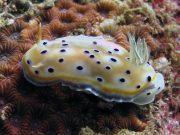
Goniobranchus geminus @ Koh Haa
The Gem Sea Slug has four coloured lines around the edge of the mantle, first a thin white line at the edge, followed by a greyish or bluish-purple line, thirdly another white line and finally a strong yellow line. The main body is pale yellowish to beige to tan with numerous white-edged purple to purple-brown spots. The rhinophores (tentacles on top of the head) are purple or yellow, the gills are whitish with brownish edges.
The Gem Sea Slug grows to 5 cm. The foot extends beyond the rear of the mantle and the upper foot is similarly patterned to the mantle.
White-margin Sea Slug
(Glossodoris rufomarginata)
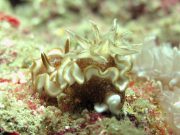
Glossodoris rufomarginata @ Koh Haa
The White-margin Sea Slug has a reddish speckled body, surrounded by a wide, wavy mantle with a fine reddish-orange border surrounding a wide white band.
The rhinophores (tentacles on top of the head) and gills are reddish-orange and white. The foot also has a white margin.
The White-margin Sea Slug grows to 5 cm, but usually observed around 3 cm.
Girdled Glossodoris
(Glossodoris cincta)
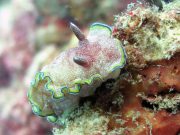
Glossodoris cincta @ Koh Haa
The Girdled Glossodoris has a dark to pale reddish brownish body and rhinophores with scattered white spots of varying sizes. The body is often darker around the base of the rhinophores.
The wavy mantle has a three-part marginal band which is variably coloured from whitish-blue to dark blue/black to yellow. This species has different colour forms depending on location.
The Girdled Glossodoris grows to 5 cm.
Beautiful Risbecia
(Risbecia pulchella)
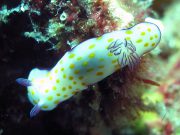
Risbecia pulchella @ Koh Haa
The Beautiful Risbecia has a creamy-whitish upper body, lower body and foot. The slightly wavy mantle margin is purple and the body is covered in many yellow-orange spots. The rhinophores have a white stem and purple leaves, and the gills are whitish with purple or orange margins.
The Beautiful Risbecia is a large nudibranch, growing to 11 cm, often found in pairs, feeds on sponges.
Cheesecake Nudibranch
(Doriprismatica atromarginata)
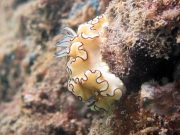
Doriprismatica atromarginata @ Koh Talabeng
The Cheesecake Nudibranch has a creamy-white to lemon-yellow body with a deep purple to black-edged wavy mantle. The rhinophores have a whitish stem and dark grey to black leaves, and the gills are creamy whitish with dark grey margins. There are dark rings at the base of the rhinophores.
The Cheesecake Nudibranch grows to 9 cm and raises its ruffled margin up from the seafloor. This nudibranch can be found close to sponges of the Fasciospongia, Spongia and Luffariella genera.
Ringed Chromodoris
(Chromodoris annulata)
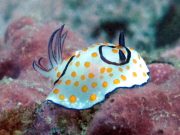
Chromodoris annulata @ Koh Phi Phi
The Ringed Chromodoris has a whitish body colour, often with many yellow spots. There is a distinct purple ring around both the gills and rhinophores.
The mantle has a bluish to purple margin.
A variation of the Ringed Chromodoris has a line joining both rings together. The Ringed Chromodoris grows to 10 cm. The diet includes sponges.
Three-Lobed Ceratosoma
(Ceratosoma trilobatum)
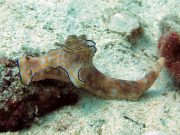
Ceratosoma trilobatum @ Koh Rok
The Three-Lobed Ceratosoma is unusually shaped, with three mantle lobes, one at the front, and two at the side of the body, just forward of the gills. These lobes give the appearance of a flattened mantle.
Around the edge of each lobe is a concentration of 'repugnatorial glands' containing a toxic substance which is excreted as a defensive measure when attacked. This toxic substance is derived from chemicals extracted from the diet.
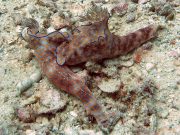
Ceratosoma trilobatum @ Koh Rok
The Three-Lobed Ceratosoma has a long, tapering foot and is variabled coloured, from pale shades, through to an orange-brown or red colour.
The body is often mottled and spotted with lighter colours (not always), and there is often a characteristic thin purple band along most of the mantle edge.
The Three-Lobed Ceratosoma grows to 10 cm and is usually found over sand and rubble areas close to the reef edge.
Diving with Chromodorid Nudibranches around Koh Lanta
Scuba Diving & Snorkel Trips
If you'd love a chance to spot Chromodorid Nudibranches on one of our daily high season diving trips from Koh Lanta then send us an email to info@diveandrelax.com.
Join our high season speedboat dive trips to some of Thailand's best dive sites and enjoy small groups, short journey times, with a focus on great personal service, safety and fun.
Not yet a certified diver? Learn to Scuba Dive on Koh Lanta with the 3 day SSI Open Water Diver course.
Book online to save 10% on dive trips and scuba courses on Koh Lanta.
Find Out More
Indo-Pacific Marine Life Guides
- Allen, G., Steene, R., Humann, P., DeLoach, N. (2003) Reef Fish Identification, Tropical Pacific. Jacksonville, FL., USA: New World Publications, Inc., ISBN 1-878348-36-1.
- Humann, P., DeLoach, N., (2010) Reef Creature Identification, Tropical Pacific. Jacksonville, FL., USA: New World Publications Inc., ISBN 978-1-878348-44-9
- Debelius, H. (2013) Indian Ocean Reef Guide. Frankfurt, Germany: IKAN - Unterwasserarchiv, ISBN 978-3-939767-52-7.
- Debelius, H. (2004) Nudibranchs and Sea Snails, Indo-Pacific Field Guide. Frankfurt, Germany: IKAN - Unterwasserarchiv, ISBN 3-925919-51-1
- Erhardt, H., Knop, D. (2015) Corals Indo-Pacific Field Guide. Frankfurt, Germany: IKAN - Unterwasserarchiv, ISBN 3-925919-69-4.
- Veron J.E.N., Stafford-Smith M.G., Turak E. and DeVantier L.M. (2016). Corals of the World
